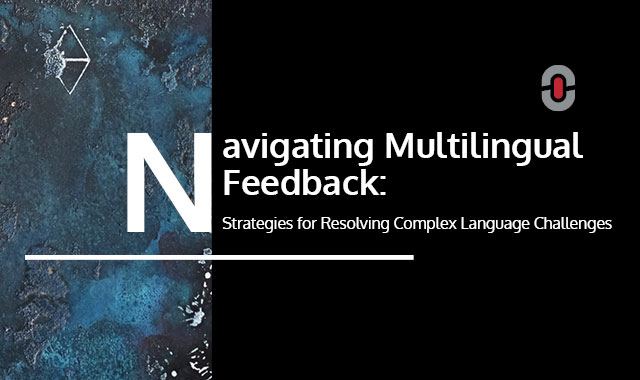The number of transnational companies is rising, creating many opportunities for economic and business growth. Access to a wide customer base in a location that is not limited to an organization’s home country is a profitable endeavor. But it comes with certain challenges.
One example of this is the multilingual barriers that arise when an international organization is attempting to communicate with its customers in another country. How does one gauge the sentiment of the client’s feedback in a different language? What steps should be taken? What are some of the corrective measures that need to be implemented?
And finally, can we learn from prior mistakes? The answer to the last question is “yes” and in this article, we explore the topic of corrective feedback in greater detail to learn from lessons from the past and improve performance going forward.
What is corrective feedback and where is it used?
Imagine that you are an international business that is expanding to different global territories. Apart from ensuring that you provide a high-quality product and service, strengthening your brand’s overseas reputation, building customer loyalty, and creating a positive customer experience, there are also challenges of translating customer feedback to ensure that you take the right corrective actions so that you do not lose them.
Research shows that client feedback and taking steps to resolve any issues is one of the best ways to retain customer loyalty. And customer loyalty translates into greater profits for the business. The alternative is a loss of customers, loss of profits, and a poor reputation in a local market, which could affect the business’ overall standing in that country. This is why it’s important to look at what corrective feedback is and why it is used.
In many cases, when a business is seeking to gauge its impact and the quality of its products or services on its customers, it sends out surveys, collects data from social media, carries out sentiment analysis, and even evaluates the results of the business’ net promoter score. Each of these feedback mechanisms is crucial in ensuring that a customer’s feedback is integrated into the business with efforts made to see to it that the customer isn’t lost, their point of view is taken into account, and that corrective steps are taken to improve the customer experience.
This is why corrective feedback can be defined as the process when a customer of an organization sends feedback, this feedback is thoroughly analyzed, and finally, remedial steps are taken to correct any negative customer experiences in the future for greater customer loyalty. Corrective feedback is used by hundreds of international organizations to ensure the quality of their output. However, the challenge arises when there are linguistic barriers between the parent organization and its local target market in another country.
Why is corrective feedback important and what are its benefits?
Learning from one’s errors and taking steps to correct them is part of the process of corrective feedback. From a linguistic point of view, the barriers that may arise between an organization and its local customers in a foreign market are huge. Slang and idioms are just some of the linguistic difficulties that need to be addressed. Others include an absence of a “knowledge base” or access to resources.
Yet further challenges may involve cultural nuances that are expressed linguistically such as honorifics and others. However, despite these challenges, there are numerous benefits of corrective feedback that must be factored into an organization’s international expansion efforts in order to better and more successfully penetrate new markets. Some of these include the following:
- You’ll get an improved understanding of your global audience
- You can make data-driven, more precise, and accurate decisions
- You’ll be able to save on time, costs, and resources further down the road, and
- Your organization will be able to enhance the customer experience and boost customer loyalty.
Learning from the past: A 1-Stop Asia case study on corrective feedback
At 1-Stop Asia, we have in-depth processes for assessing the quality of our translation efforts and high standards in terms of producing quality output. However, as with most things in life, we are humans and sometimes mistakes can be made. Looking at a past client who requested JA and TH translations to EN, we received feedback regarding a transcription and TEP project.
Among the feedback included issues such as:
- Communication challenges
- Numerous AMs being involved in the project due to local holidays
- The fact that only one PM handled in Asia
- Several extensions were requested at the wrong time
- Production issues with regard to files, resource allocation, and instructions
- Delivery issues including wrong format files that led to additional delays
- Quality issues of the final delivery files, which led to additional delays and extended further communication
To resolve this issue, a Feedback Officer was assigned to the case to investigate the challenges involved in this project. As part of their findings, they produced a set of recommendations to ensure that such challenges do not arise again in the future. Among these corrective steps include:
Linguistic quality

- Appoint a native English speaker to review all projects from the client as part of the instructions and in the profile of the client in our database.
- Double-check the reasons why the QA tool missed errors that should be detectable by it like typos, misspellings, or others.
- Identify whether the standard workflow of a translation has been followed. Here, after receiving the file, a translator has to check if there are any special instructions/notes given regarding the file. While translating, make sure to follow a style guide/terminology. And, after translation do QA, to eliminate basic errors and make corrections according to it, if any, and self-proofread and deliver the file.
- Discuss a Style Guide and if not available, create one and coordinate with the client.
- Assign linguists that have reliable quality assurance and proofreading skills
Communication issues
- Perform an internal audit for the primary AM, who quoted the project on communication
- skills with clients. If necessary, prepare an assessment and provide additional training on communication with clients.
- With the AM & PM – revisit the workflow of this client and make sure to identify critical points and criteria for communicating extensions and other project management issues.
- Create awareness of recognition when escalation is necessary.
Project Management
- Revisit the workflow for this client.
- Create custom checklists for all levels of project management for the client including positions: AM, PM, RM, and linguists.
- Coordinate these checklists with the client and after that perform training at all levels of the project management with a test at the end.
- Provide checklists in a file to the client and add them as an attachment to the client’s instructions.
- Make sure to include a statement upon delivery that all has been done according to the agreed-upon process.
Looking ahead
The process of corrective feedback should not be viewed as a closed loop but as an ongoing process that is constantly being refined and streamlined. Whenever customer feedback comes into the picture, it’s essential to quickly and efficiently respond to it so that the customer experience can and will be improved and customer loyalty maintained.
At 1-Stop Asia, we take corrective feedback very seriously and endeavor to ensure that each client is absolutely satisfied with the quality of our work. A key lesson from the experience mentioned above is that persons involved in the processes of providing linguistic services should not shy away from customer feedback, areas for improvement need to be identified, and then steps should be taken to resolve the issues to ensure improved outcomes.
